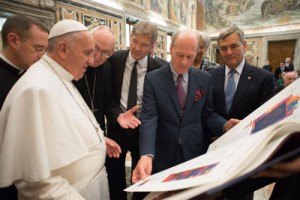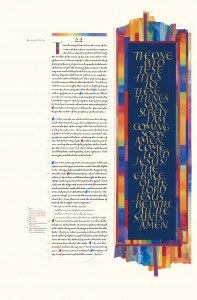by Dennis Dalman
editor@thenewsleaders.com
Without uttering a word, Pope Francis with just a smile and arm gestures gave his blessing and approval to The Saint John’s Bible at the Vatican recently.
The last volume of the historic work, Volume 7, was shown to the Pope in a room filled with people. The book’s presenters were the project’s artistic director and calligrapher Donald Jackson; Abbot John Klassen of St. John’s Abbey; Michael Hemesath, president of St. John’s University; and Dan and Katherine Whalen, who are financial supporters of SJU, the Abbey and the The Saint John’s Bible project. Dan is an SJU trustee.
The St. Peter Apostles Edition of the massive handwritten Bible was given as a gift to the Holy See thanks to the Gerald and Henrietta Rauenhorst Foundation.
The group of visitors showed Pope Francis the “Vision of the New Jerusalem,” as well as the last page of Revelation with “The Great Amen” at the very end of the book.
The “New Jerusalem” passage speaks of the fulfillment of the Old Testament prophecy that the gates of the heavenly city will never close and will always be open to welcome all people from every nation on Earth.
“He (the Pope) began to sense the beauty of the illumination and illustrations,” Jackson said, as quoted in an article on the St. John’s University website. “I showed him the illumination of the New Jerusalem and at that point he raised up his arms with an expression of joy…I am proud to represent the team of skilled artists and printers who have striven to make the Word of God come alive on the pages of this edition of The Saint John’s Bible.”
Jackson is the official scribe and calligrapher to the Crown Office of the United Kingdom of Great Britain and Northern Ireland. The Letters and Revelation section was written and illustrated by Jackson, unlike the rest of The Saint John’s Bible, most of which was the result of a seamless coordination among many calligraphers and artists.
The volume the Pope saw is 2 feet x 3 feet and weighs 14 pounds. It was completed in 2011. It is not the first time the widely heralded work has been presented at the Vatican. Pope Benedict also marveled when he saw earlier volumes of the project.
Hemesath said he was very moved to be among those who presented Letters and Revelations to the Pope.
“It was a rare honor and privilege,” he said. “The Saint John’s Bible is yet another example of the ways the monks of St. John’s impact the word far beyond Collegeville. From preserving cultures thorough the Hill Museum and Manuscript Library to their role in the liturgical reforms and ecumenical movement of Vatican II to envisioning the first handwritten Bible in 500 years, the monastic community at St. John’s serves the Church and the world in exceptional ways.”
Background
When he was a child, Donald Jackson used to dream about someday creating a handwritten, illuminated Bible.
Many years later, after he had become famous as a master calligrapher, he mentioned his childhood dream to Eric Hollas, OSB, a monk at St. John’s Abbey and then-director of the Hill Museum and Manuscript Library. Inspired by Jackson’s ambitious idea, Hollas told the other monks about it in 1995. They, too, embraced Jackson’s dream, and the long coordination and funding mechanisms for the project began. The work involved intricate coordination among people at St. John’s Abbey and at the scriptorium in Wales, where most of the actual calligraphy and illuminated illustrations were done under Jackson’s supervision.
What seemed to many skeptics as a virtually impossible task turned into a labor of love that took 15 years to complete. The Saint John’s Bible, all seven volumes of it, weighs more than 165 pounds. The original was written on calf-skin vellum using pens and inks used by medieval monks hundreds of years ago. The 1,150-page work contains 160 richly colored illuminated illustrations. Many of the flora and fauna depicted in the illuminations were based on those found in the St. John’s Abbey area.
The Saint John’s Bible has been hailed as one of the greatest examples of the art of bookmaking in the history of the world. The entire Bible or volumes of it have been displayed in museums and other venues far and wide.
The “home” for the original pages is the Hill Museum and Monastic Library, where many of its pages are always on display for free viewing by the public. The gallery on the St. John’s University campus is open from 8 a.m.-4:30 p.m. Monday-Friday. From the first weekend of May through mid-December, the gallery is also open Saturdays from noon-4 p.m. The museum is closed during weekends for the remainder of the year. For more information about seeing pages from The Saint John’s Bible or other exhibitions, call 320-363-3351 or 320-363-3514.

Pope Francis beholds some of the pages of The Saint John’s Bible. From left to right are (starting from just to the right of the Pope) Abbot John Klassen of St. John’s Abbey; Michael Hemesath, president of St. John’s University; master calligrapher and artistic director of The Saint John’s Bible; and Katherine and Dan Whalen, supporters of SJU and the Abbey. Dan is a trustee for SJU.

The final two verses of Revelation and of the entire Bible are a promise from Christ that he is coming and a petition from the church that he come soon. The author cries out on behalf of humanity, “Amen – may it be so.” That cry of hope concludes with a prayer that the grace of Jesus be with all. The page shown here is one of the pages seen recently by Pope Francis when the seventh volume of The Saint James Bible was shown at the Vatican.




